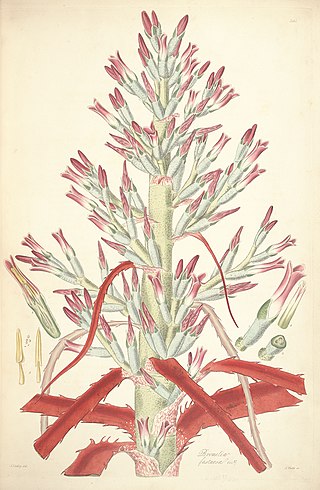
Aechmea angustifolia is a plant species in the genus Aechmea. This species is native to Central America and northern South America.

Aechmea mertensii is a plant species in the genus Aechmea. This species is native to Bolivia, Brazil, Colombia, Ecuador, Guyana, French Guiana, Peru, Suriname, and Venezuela.

Aechmea magdalenae is a flowering plant in the Bromeliaceae family. It is also known as ixtle. This species is native to Central America, southern Mexico, Colombia and Ecuador. The specific epithet magdalenae comes from the place it was discovered, the Rio Magdalenae Valley in Colombia. The long green leaves feature fierce spines and may reach about 2.5 meters tall. In nature, it is found in moist and swampy woods. The flowers are red and give way to edible fruits.

Bromelia pinguin is a plant species in the genus Bromelia. This species is native to Central America, Mexico, the West Indies and northern South America. It is also reportedly naturalized in Florida. It is very common in Jamaica, where it is planted as a fence around pasture lands, on account of its prickly leaves. The plant can be stripped of its pulp, soaked in water, and beaten with a wooden mallet, and it yields a fiber whence thread is made. In Nicaragua and El Salvador it is used to make gruel.

Pitcairnia heterophylla is a plant species in the genus Pitcairnia. This species is native to northern South America, Central America, and central and southern Mexico.
Werauhia hygrometrica is a species of flowering plant in the Bromeliaceae family. It is native to Costa Rica, Mexico, Venezuela and Ecuador.
Aechmea corymbosa is a plant species in the genus Aechmea. This species is native to Venezuela, Colombia, Peru, Brazil and Ecuador.

Aechmea dactylina is a plant species in the genus Aechmea. This species is native to Costa Rica, Nicaragua, Panama, Colombia and Ecuador.

Aechmea longifolia is a species of flowering plant in the genus Aechmea. This species is native to Bolivia, Venezuela, Colombia, the Guianas, northern Brazil, Peru and Ecuador.

Aechmea setigera is a plant species in the genus Aechmea. This species is native to Bolivia, Venezuela, Colombia, Panama, Suriname, French Guiana, Ecuador, and northern Brazil.
Ronnbergia veitchii is a species of flowering plant in the family Bromeliaceae, native to Costa Rica, Panama, Colombia, Peru and Ecuador. It was first described in 1877 as Aechmea veitchii.

Billbergia macrolepis is a species of flowering plant in the genus Billbergia. This species is native to Costa Rica, Panama, Colombia, Ecuador, Venezuela, and Guyana.
Greigia columbiana is a plant species in the genus Greigia. This species is native to Costa Rica, Panama, Colombia, Ecuador, and Venezuela.

Guzmania coriostachya is a plant species in the genus Guzmania, and is native to Costa Rica, Panama, Colombia, Venezuela and Ecuador.
Guzmania donnellsmithii is a plant species in the genus Guzmania. This species is native to Costa Rica, Panama, Nicaragua, and Ecuador.

Guzmania musaica is a plant species in the genus Guzmania. This species is native to Costa Rica, Panama, Ecuador, Venezuela and Colombia.
Mezobromelia pleiosticha is a species of flowering plant in the family Bromeliaceae. This species is native to northwestern South America.

Pitcairnia maidifolia is a plant species in the genus Pitcairnia. This species is native to Central America and northern South America.

Aechmea pubescens is a species of flowering plant in the Bromeliaceae family. This species is native to Costa Rica, Honduras, Nicaragua, Panama, Colombia and Venezuela.
Racinaea adpressa is a species of flowering plant in the Bromeliaceae family. It is native to Costa Rica, Venezuela and Ecuador.













